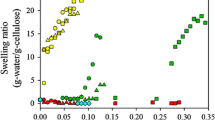Abstract
Two types of Sisal cellulose were studied as starting material for homogeneous acylation in the solvent dimethyl sulfoxide (DMSO)/tetrabutylammonium fluoride trihydrate (TBAF). The native Sisal cellulose investigated contains 14% hemicellulose (mainly composed of xylose) as confirmed by 13C-NMR spectroscopy in DMSO-d6/TBAF and HPLC analysis after complete polymer degradation. Alkali treatment of Sisal cellulose decreases the amount of hemicellulose, the degree of polymerization and the crystallinity. Both Sisal cellulose samples can be dissolved in DMSO/TBAF after treatment at elevated temperature. GPC measurements showed high aggregation in the solution. Different homogeneous acylation reactions using carboxylic acid anhydrides and vinyl esters were carried out, showing a pronounced tendency of the anhydride towards hydrolysis in the solvent. This disadvantage can be diminished by decreasing the amount of the salt hydrate (TBAF trihydrate) or by a distillative removal of the majority of water. A strong interaction of the polymer with the water in the solvent was observed.
Similar content being viewed by others
References
Ass B.A.P. and Frollini E. 2001. Aggregation of cellulose during dissolution and acetylation in N,N-dimethylacetamide/lithium chloride: an introductory study. Anais Assoc. Bras Quím. 50: 76-82.
Browning B.L. 1967. Methods of Wood Chemistry. Vol. 2. John Wiley, New York.
Buchanan C.M., Edgar K.J., Hyatt J.A. and Wilson A.K. 1991. Preparation of cellulose [1-C-13] acetates and determination of monomer composition by NMR spectroscopy. Macromolecules 24: 3050-3059.
Buschle-Diller G. and Zeronian S.H. 1992. Enhancing the reactivity and strength of cotton fibers. J. Appl. Polym. Sci. 45: 967-979.
Ciacco G.T., Ass B.A.P., Ramos L.A. and Frollini E. 2000. Acetylation of cellulose under homogeneous reaction conditions. In: Mattoso L.H.C., Leão A.L. and Frollini E. (eds), Natural Polymers and Composites. São Carlos, Brazil, pp. 139-145.
Das Gupta P.C. and Mukherjee P.P. 1967. The hemicellulose of Sisal fibre (Agave sisalana). J. Chem. Soc. C: 1179-1182.
El Seoud O.A., Regiani A. and Frollini E. 2000. Derivatization of cellulose in homogeneous conditions. A brief review. In: Frollini E., Leão A.L. and Mattoso L.H.C. (eds), Natural Polymers and Agrofibers Composites. São Carlos, Brazil, pp. 73-90.
Heinze T. 1998. New ionic polymers by cellulose functionalization. Macromol. Chem. Phys. 199: 2341-2364.
Heinze T., Dicke R., Koschella A., Kull A., Klohr E. and Koch W. 2000. Effective preparation of cellulose derivatives in a new simple cellulose solvent. Macromol. Chem. Phys. 201: 627-631.
Heinze T. and Glasser W.G. 1998. The role of novel solvents and solution complexes for the preparation of highly engineered cellulose derivatives. In: Heinze T. and Glasser W.G. (eds), Cellulose Derivatives: Modification, Characterization, and Nanostructures. American Chemical Society, Washington, DC, pp. 2-18, ACS Symposium Series No. 688.
Heinze T. and Liebert T. 2001. Unconventional methods in cellulose functionalization. Progr. Polym. Sci. 26: 1689-1762.
Heinze T., Liebert T., Klüfers P. and Meister F. 1999. Carboxymethylation of cellulose in unconventional media. Cellulose 6: 153-165.
Heinze T. and Schaller J. 2000. New water soluble cellulose ester synthesized by an effective acylation procedure. Macromol. Chem. Phys. 201: 1214-1218.
Hon D.N.S. 1994. Cellulose: a random walk along its historical path. Cellulose 1: 1-25.
Isogai A. and Attala R.H. 1998. Dissolution of cellulose in aqueous NaOH solution. Cellulose 5: 309-319.
Kawanishi H., Tsunashima Y. and Horii F. 1998. A nest of structures in dynamics of cellulose diacetate in N,N-dimethylacetamide in quiescent solution state studied by dynamic light scattering. J. Chem. Phys. 109: 11027-11031.
Klemm D., Heinze Th., Philipp B. and Wagenknecht W. 1997. New approaches to advanced polymers by selective cellulose functionalization. Acta Polymerica 48: 277-297.
Klemm D., Schmauder H.-P. and Heinze T. 2002. Cellulose. In: Vandamme E., De Baets S. and Steinbüchel A. (eds), Biopolymers: Biology, Chemistry, Biotechnology, Applications, Polysaccharide II. Wiley-VCH, Weinheim, Germany, pp. 277-319.
Liebert T. and Heinze T. 1998. Synthesis path versus distribution of functional groups in cellulose ethers. Macromol. Symp. 130: 271-283.
Liebert T. and Heinze T. 2001. Exploitation of reactivity and selectivity in cellulose functionalization using unconventional media for the design of products showing new superstructures. Biomacromolecules 2: 1124-1132.
Marson G., Ciacco G.T., Frollini E. and El Seoud O.A. 2000. An efficient one pot acylation of cellulose under homogeneous reaction conditions. Macromol. Chem. Phys. 201: 882-889.
Marson G., Regiani A., Frollini E. and Seoud O.A. 1999. Cellulose esterification in homogeneous medium. J. Polym. Sci. A: Polym. Chem. 37: 1357-1363.
McCormick C.L., Callais P.A. and Huchinson B.H. Jr. 1985. Solution studies of cellulose in lithium chloride and N-N-dimethylacetamide. Macromolecules 18: 2394-2401.
Morgenstern B. and Kammer H.W. 1996. Solvation in cellulose-LiCl-DMAc solutions. Trends Polym. Sci. 4: 87-92.
Morgenstern B. and Kammer H.W. 1999. On the particulate structure of cellulose solutions. Polymer 40: 1299-1304.
Nelson R. and Oliver D.W. 1971. Study of cellulose structure and its relation to reactivity. J. Polym. Sci. C 36: 305-320.
Schurz J. 1999. Trends in polymer science-A bright future for cellulose. Progr. Polym. Sci. 24: 481-483.
Sealey J., Samaranayake G., Todd J. and Glasser W. 1996. Novel cellulose derivatives. IV. Preparation and thermal analysis of waxy ester of cellulose. J. Polym. Sci. 34: 1613-1620.
Sun R.C., Fang J.M., Tomkinson J., Geng Z.C. and Liu J.C. 2001. Fractional isolation, physico-chemical characterization and homogeneous esterification of hemicelluloses from fast-growing poplar wood. Carbohydr. Polym. 44: 29-39.
Author information
Authors and Affiliations
Corresponding author
Rights and permissions
About this article
Cite this article
Ciacco, G.T., Liebert, T.F., Frollini, E. et al. Application of the solvent dimethyl sulfoxide/tetrabutyl-ammonium fluoride trihydrate as reaction medium for the homogeneous acylation of Sisal cellulose. Cellulose 10, 125–132 (2003). https://doi.org/10.1023/A:1024064018664
Issue Date:
DOI: https://doi.org/10.1023/A:1024064018664




